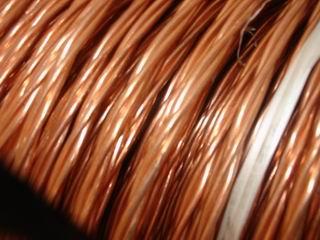(单词翻译:单击)
Even in the world of medicine, what is old is new again.
即使是在医学界,那些古老的东西又重新流行起来。
Thousands of years ago, Egyptians used it to sterilize drinking water.Ancient Romans, Aztecs and Greeks also used it for medical treatments.
几千年前,埃及人用它来为饮用水消毒。古罗马人、阿兹特克人以及希腊人都用它进行医疗。
I am talking about copper.
我说的就是铜。
The symbol for copper on the periodic chart for elements is Cu.If we are talking about germs that might mean Cu later! (C + u = "See you")
元素周期表上铜的符号为Cu。如果我们在讨论细菌,那么铜就意味着与细菌说再见。(Cu:C+u="See you"(再见))
Copper kills many germs on contact.Now it is back in hospitals to do just that.
铜可以杀死很多细菌。现在医院也开始用铜杀菌。
One of the major ways we get sick is we touch surfaces out in the world, many made of metal or plastic.These surfaces are covered with germs.Germs live on poles on a train or bus.They are found on doorknobs and handles.
生病的原因之一就是我们接触到外界很多金属或者塑料制成的表面。这些表面有很多细菌。火车或者公共汽车的柱子上也会滋生细菌。门把手和手柄上亦是如此。

This is especially true in hospitals.Bill Keevil is a microbiologist at Southampton University in Britain.He is investigating the properties of copper that kill germs -- or as researchers call them, pathogens.
医院里更是这样。Bill Keevil是英国南安普敦大学的微生物学家。他正对铜的特性展开研究,即铜能够杀灭细菌(研究人员所说的病原体)。
Keevil points to studies that compare infection rates at U.S. hospitals that use copper surfaces and those that do not.
Keevil在这些研究中将使用铜做表面的医院和未使用铜做表面医院中的感染率进行了对比。
"They found that copper alloys gave a 58 percent reduction in infection rate.So that showed, you know, that in the real world of a hospital environment, copper alloys do a great job."
“他们发现铜合金能够将感染率降低58%。这也表明,在真实的医院环境中,在防止感染方面,铜合金会发挥重要的作用。”
In a study published in the journal mBio, Keevil and his team found that copper surfaces can quickly kill the coronavirus 229E.
在《生物分子技术》(mBio)期刊上发表的一项研究表明,Keevil及其团队发现铜表面能够快速杀死冠状病毒229E。
You may not know coronavirus 229E by name.
或许你并不了解冠状病毒229E。
But if you ever have had a common cold or the more serious pneumonia, you have been in contact with it.
但如果你患过感冒或者更严重的肺炎,那么你感染的就是此类病毒。
The coronavirus 229E is also closely related to the pathogen that causes SARS and MERS.
此外,冠状病毒229E还与引起SARS和MERS的病原体密切相关。
Keevil explains that copper ions -- electrically charged molecules -- kill dangerous viruses by destroying their genetic material.Copper ions do this by interacting with oxygen and changing the oxygen molecules.As a result, the virus cells cannot mutate.
Keevil解释道:铜离子(带电分子)通过破坏病毒的遗传物质将病毒杀死。铜离子通过与氧气作用,改变氧分子。结果,病毒细胞不再能产生突变。
"Now these ions are able to punch holes in the cell's membrane, enter the cell and destroy their nucleic acid.So they are completely killed.There's no chance of mutation leading to resistance, and there's no coming back.So the chemistry is fantastic."
“这些离子能够穿破细胞膜,进入细胞,破坏其核酸。将病毒彻底杀死。不可能有机会产生变异抗体,病毒也一去不复返。化学就是如此奇妙。”
Keevil notes that ancient civilizations knew about the germ-killing properties of copper.However, they may not have understood the science behind it.
Keevil注意到一些古文明早已了解铜能消毒的属性。但他们可能并不了解背后的科学原理。
Researchers at the U.S. National Institutes of Health wrote on their website about the oldest recorded medical use of copper.
美国国立卫生研究院的研究人员在其网页上介绍了有关铜的用途最古老的纪录。
They say its use is noted in an Egyptian medical book written about 4,000 years ago.
他们表示最早的纪录见于4000年前埃及的医书上。
The book describes how they used copper to sterilize wounds and drinking water.
书中介绍了如何利用铜对伤口和饮用水消毒。
Keevil says earlier generations of builders in the United States also knew this about copper.That is why copper alloys such as brass were often used in building materials.
Keevil表示美国早些年代的建筑师也了解铜的此项用途。这也是一些诸如黄铜的铜合金经常用作建筑材料的原因。
But more modern builders stopped using copper and copper alloys.They cost more than other building materials.
但现代的建筑师不再使用铜和铜合金。因为它们的价格比其他建筑材料高。
However, Bill Keevil says copper could save hospitals money.He says their other costs of fighting infections will drop, including drugs for treatment.
但Bill Keevil表示铜能为医院节省钱财。他表示其他抗击感染的消费会降低,其中包括治疗药物的费用。
More importantly, less people will get sick.
更重要的是,这样一来生病的人就少了。
I'm Anna Matteo.
Anna Matteo为您报道。
本栏目视频字幕与文本并不完全对应,且视频播放缓冲时间较长,敬请谅解!


